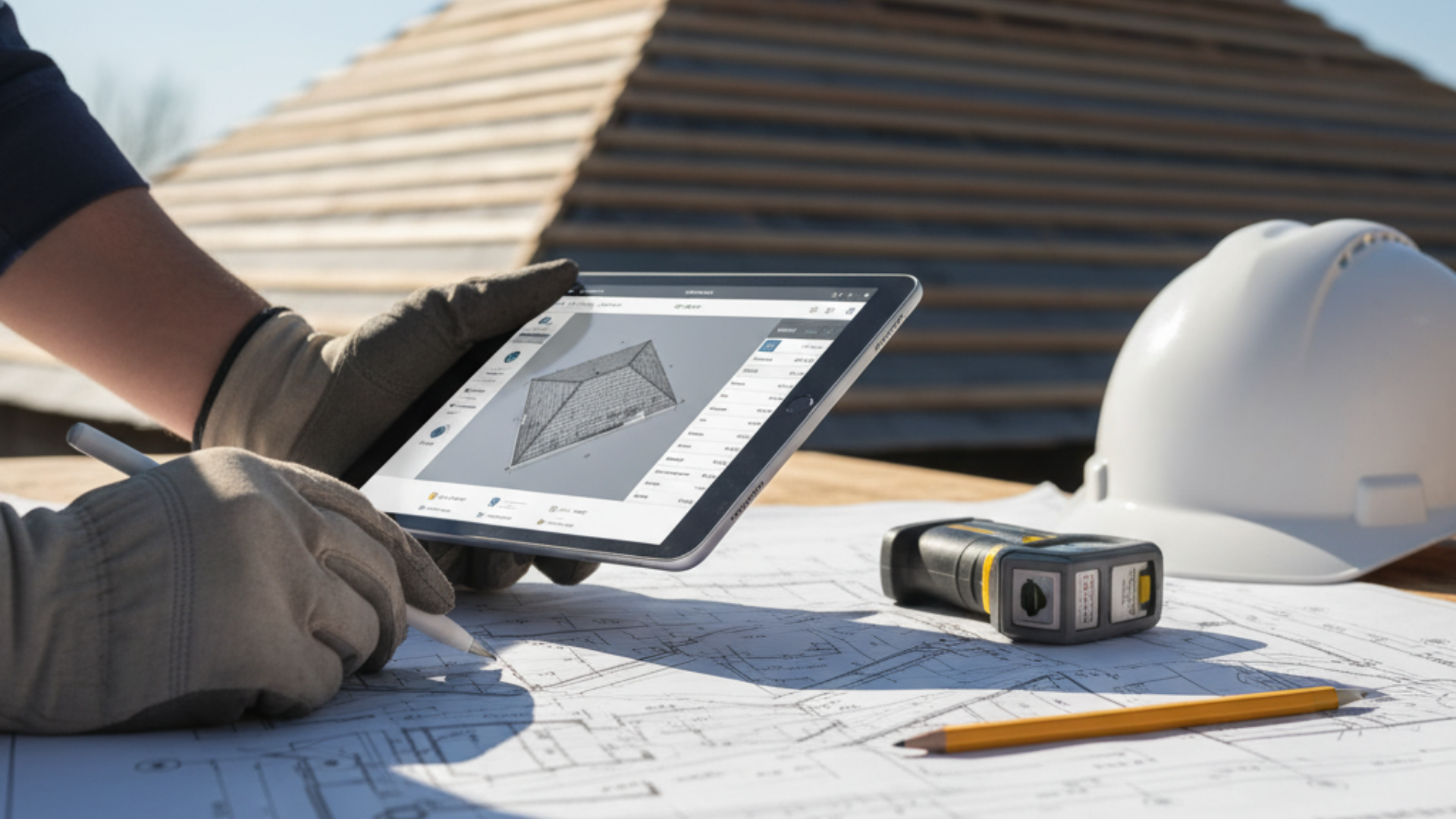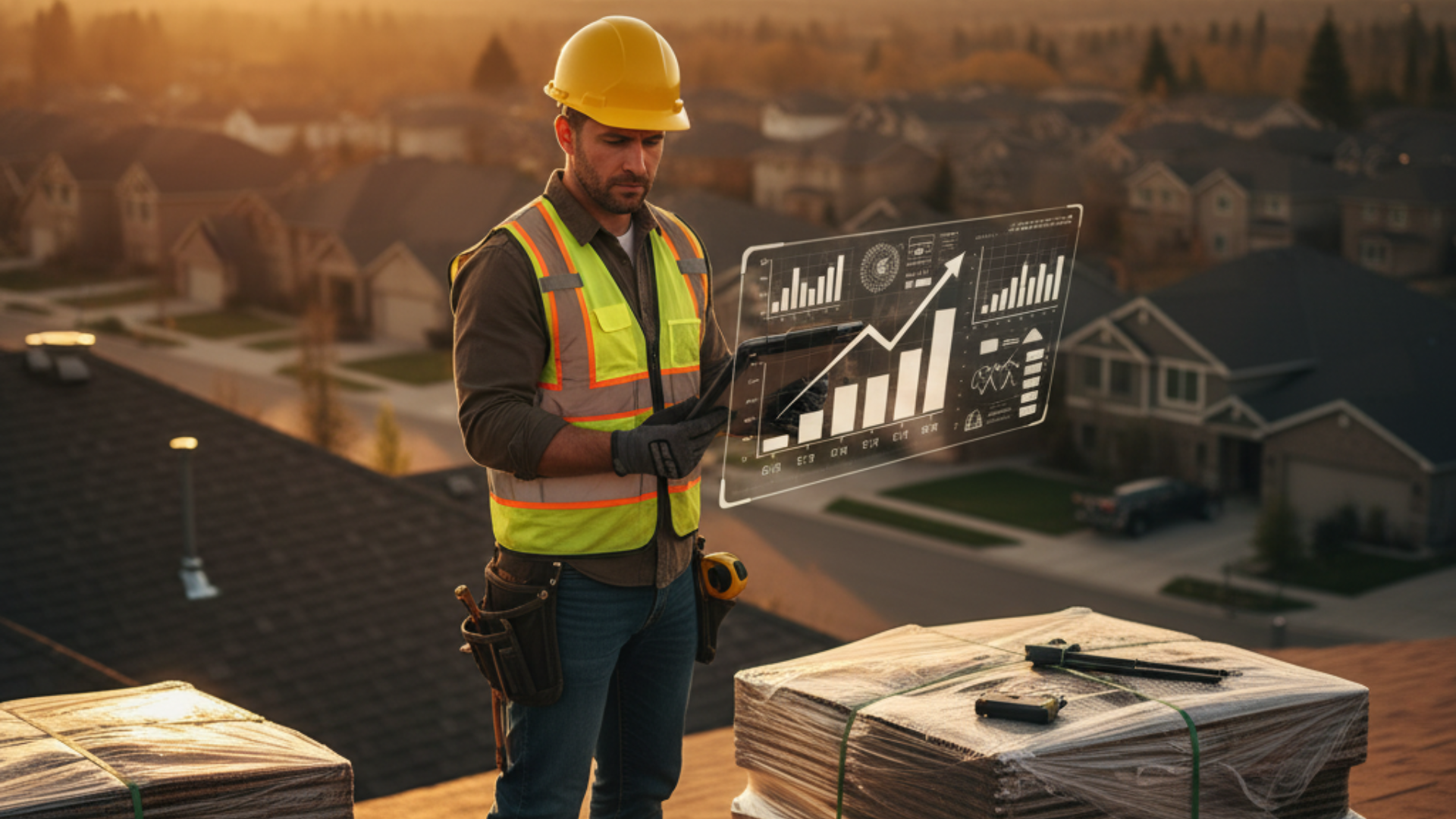November 10, 2025
If you work in roofing, you’ve probably heard of Roofr, the platform promising to handle everything from roof measurements to client proposals in a few clicks.
It’s one of the most talked-about tools in the roofing software space right now, and for good reason. It’s fast, accessible, and built around the way contractors actually quote and sell jobs.
But Roofr has evolved rapidly over the past year. New pricing tiers, integrations, and competitors have reshaped what “all-in-one” means for roofing businesses in 2025.
At the same time, contractors are rethinking their tech stacks altogether by trading niche tools for systems that connect sales, scheduling, and payments in one place.
Roofr Software Review: Is This the All-in-One Roofing Software Roofers Need in 2025?
This review takes a clear look at how Roofr performs today, where it saves you time, where it falls short, and how newer platforms like RooferBase are redefining what contractors expect from their software stack.
Key Takeaways
- Roofr remains one of the top tools for roof measurements and proposals, helping contractors quote faster and look more professional.
- Its pricing tiers can feel restrictive as teams scale, with per-report costs adding up for high-volume contractors.
- RooferBase offers a lighter, smarter alternative for teams who want one platform that handles everything from lead to payment.
- Both solutions prove that modern roofers deserve more jobs, less time, and smarter tools.
What is Roofr Software?
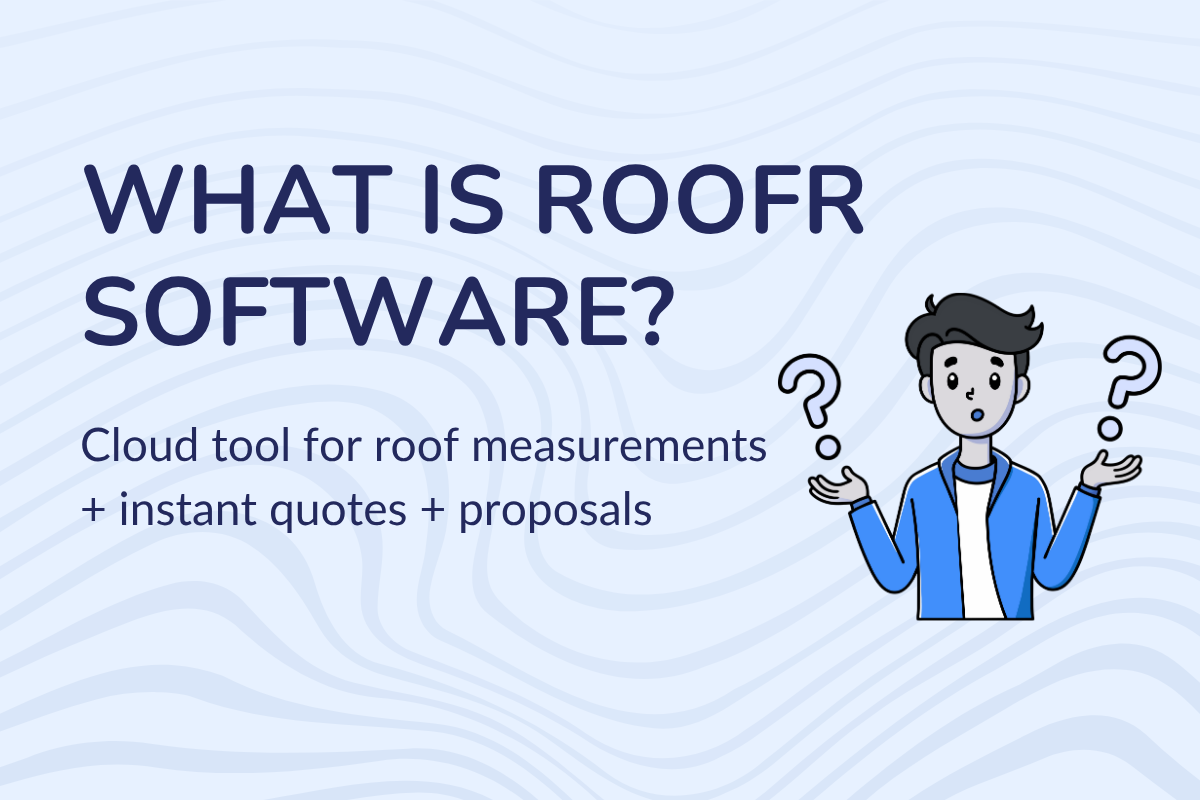
Roofr is a cloud-based platform built for roofing contractors who want to spend less time measuring roofs and formatting quotes.
It combines three essential tools, roof measurement reports, instant estimates, and digital proposals, into a single, browser-based workspace.
At its core, Roofr’s value lies in removing friction from the first half of a roofing job: the estimating and sales phase.
Contractors can order roof reports using aerial imagery, drop in pricing details, and generate professional-looking proposals within minutes. The goal isn’t to manage your entire company; it’s to help you quote faster and look more polished doing it.
Roofr also integrates with QuickBooks and Zapier, making it easier to sync proposals with accounting or CRM tools already in use. It’s lightweight, straightforward, and designed for small to mid-size teams that need speed over complexity.
Roofr’s Core Tools: Everything in One Software

Roofr positions itself as the one software roofers need to measure, quote, and close jobs faster. Its toolkit covers the early sales cycle, from takeoffs to signed proposals, with just enough automation to make it feel effortless.
1. Roof Measurement Reports
This is Roofr’s backbone feature. Contractors can order super-fast measurements based on aerial imagery, often delivered within a few hours. These reports include line measurements, slopes, and material breakdowns that slot directly into your estimates.
For teams that prefer hands-on control, Roofr also supports manual uploads, so you can adjust or verify data before sending it to a client. It gives you endless time savings for urban and suburban jobs, though accuracy can dip on tree-covered or rural properties.
Check out: Top Roof Measuring Software Compared [2025 Guide]
2. Instant Estimator
Roofr’s instant estimator tool lets homeowners request a quote directly through your website. Roofr calculates a preliminary price based on your pre-set cost structure, giving prospects a fast, transparent estimate without manual input from your team.
It’s not a final quote, but it gives contractors a leg up as leads come in pre-qualified, and you can follow up with a full proposal within minutes.
3. Proposal Builder
Roofr’s stunning proposal builder allows professionals to create proposals within minutes. You can add your logo, pricing options, and payment terms, then send the digital proposal for e-signature right from the dashboard.
It’s simple by design, has fewer settings than a full CRM, but fast enough that small teams can use it without a learning curve.
Roofr Pricing Breakdown in 2025: Free, Pro, Premium, and Elite Plans
As of 2025, Roofr’s pricing follows a clear four-tier model. The structure is simple on paper, but the value you get at each level depends heavily on how many quotes and reports you send each month.
| Plan | Best For | Monthly Price | Key Features | Notes |
|---|---|---|---|---|
| Free (Pay-As-You-Go) | Solo contractors or startups | $0/month | 5 free proposals, 1 free roof report/month, customer records dashboard | Reports beyond the free limit cost $19 each |
| Pro Plan | Small teams closing 5–15 jobs/month | $99/month | Unlimited proposals, team access, QuickBooks integration, branded templates | Report cost drops to $13 each |
| Premium Plan | Growing companies that need automation | $169/month | Faster report delivery, custom branding, analytics, and ABC Supply integration | Ideal for consistent quote volume |
| Elite Plan | Larger operations and multi-crew firms | Custom pricing | API access, onboarding support, SLA-based turnaround, dedicated account rep | Contact sales for a quote. |
Roofr’s Free (Pay-As-You-Go) tier gives contractors a functional starting point, enough to send a few proposals and try measurement reports without commitment.
The Pro Plan remains the most balanced for active users as it provides unlimited proposals and reduces per-report pricing, which can make a big difference if you quote frequently.
The Premium Plan adds speed and polish. It includes faster turnaround times for roof measurements and integrations like ABC Supply’s live material pricing, helping contractors price jobs more precisely.
Elite runs on custom contracts and is great for larger teams looking for workflow customization or CRM-level support.
Roofr doesn’t charge per user, but the cost of measurement reports still adds up, so most companies calculate ROI based on report volume rather than seat count.
How Roofr Helps Roofing Contractors Grow Their Business
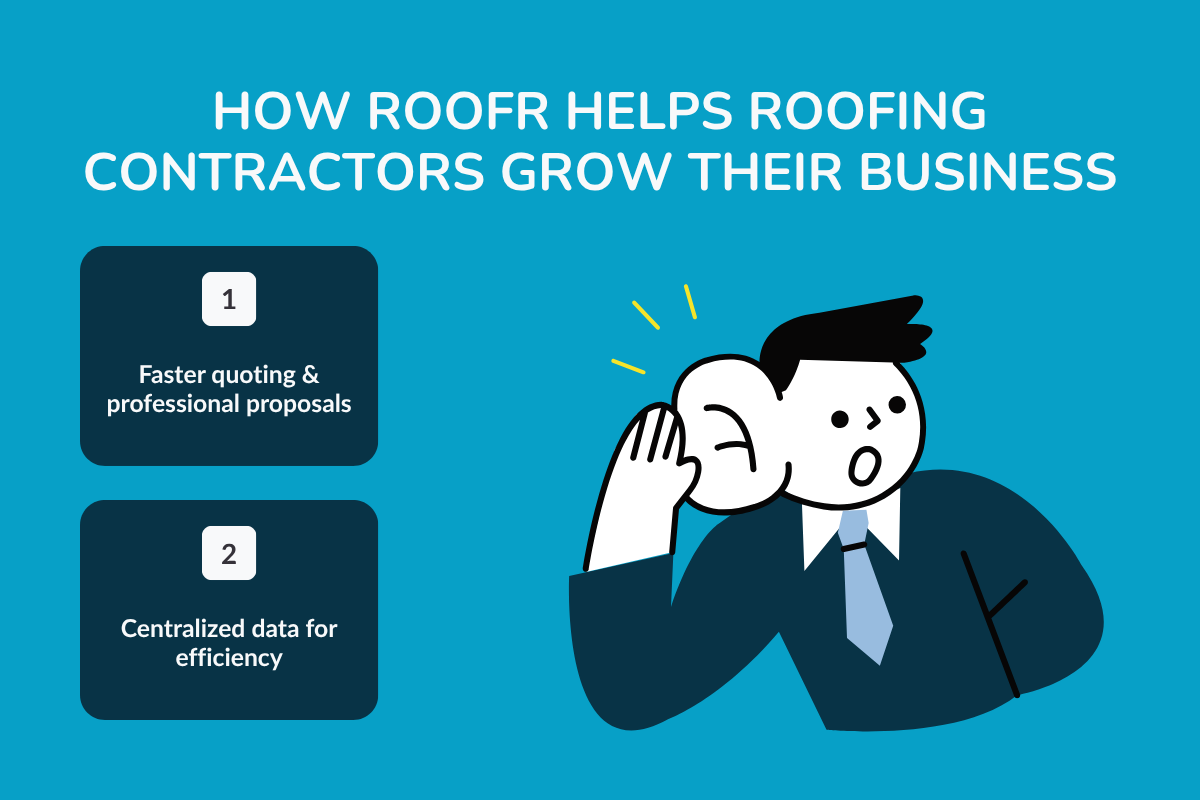
Roofr’s appeal for roofing businesses comes down to one simple promise to let you quote faster, reduce manual work, and present like a professional.
For contractors who spend too many hours measuring roofs, creating proposals, and tracking jobs, Roofr offers tangible shortcuts.
1. Speeding Up Estimates & Proposals
One of the clearest wins for roofers is Roofr’s measurement-to-proposal workflow. Contractors can order a measurement report (or self-measure) using aerial imagery, import the numbers into the system, add pricing, and send a branded proposal, all in one session.
Users say this helps them show up with meaningful numbers during a site visit rather than starting from scratch. Because fewer steps are involved, estimators and sales team members spend less time doing admin and more time building the pipeline.
2. Better Presentation, More Jobs
Roofr enables contractors to send digital, branded proposals that include measurement data, payment options, and e-signatures.
One current G2 reviewer commented that their business “doubled” after adopting Roofr, thanks to the streamlined process, which helped convert more leads.
3. Centralising Key Data
While Roofr began as a measurement and proposal tool, its 2025 product updates show that it is becoming more of a business operations platform.
For example, in Q1 2025, Roofr introduced scheduling/calendar tools, supplier integrations (ABC Supply, Beacon, SRS), and work-order/job costing features.
4. Real-World Contractor Fit
Roofing contractors interviewed or surveyed tend to highlight three consistent benefits:
- Less time spent measuring roofs manually or climbing structures.
- More professional, polished proposals that improve homeowner trust and close rates.
- Lower overhead for admin/estimating when compared to older systems or manual processes.
Roofr is especially well-suited for residential roofing businesses or small-to-mid-sized teams that close a decent volume of jobs but don’t yet have enterprise-level operations.
Its speed and ease of use are strong selling points for contractors seeking to scale without adding a full estimating department.
Real-World Challenges Roofers Still Face

Even with all the tools Roofr brings to the table, contractors still point out a few friction points that haven’t disappeared in 2025.
1. Accuracy Gaps in Certain Roof Types
Roofr’s measurement reports are fast, but not flawless. Contractors note that dense tree cover, complex rooflines, and low-resolution imagery can still lead to manual corrections once they reach the job site.
The Roof Proposal tool does make quoting more efficient afterward, but the initial data occasionally requires a double check, especially for custom builds and metal roofs.
2. Limited Control Over Design and Branding
Roofr’s templates look clean, but they’re also fairly rigid. Larger teams often want to create more visual flexibility, from proposal layouts to how photos and disclaimers appear.
While the company has expanded customization in its Premium and Elite tiers, the editing experience is still lighter than full roofing sales software suites like AccuLynx or JobNimbus.
3. Scaling Costs and Workflow Overlaps
The subscription cost itself is predictable, but the per-report charges can pile up for high-volume contractors.
Add in separate tools for scheduling or material tracking, and the workflow feels fragmented, exactly what many were trying to fix by consolidating into “one software.”
For small shops, that’s manageable. For growing teams, it can get expensive before they sign deals at scale.
4. Mobile and On-Site Experience
Roofr’s browser-based design keeps it accessible, but mobile optimization remains a weak spot. On-the-go estimators report slower loading times when pulling data mid-project. The system runs best in the office, not necessarily while balancing a tablet on a roof edge.
5. Room to Grow in Reporting and Analytics
Roofr’s data tracking provides quick summaries, but deeper insights, such as sales conversion by region or by estimator, are still limited. Some users call for a more efficiently designed reporting module that ties back to leads and marketing ROI.
Still, it’s worth noting that Roofr’s overall experience rates highly in user satisfaction. Most contractors describe it as “simple, fast, and amazing for what it does.” It’s clear the platform knows its lane speed, simplicity, and reliability, even if it hasn’t solved every workflow bottleneck yet.
Roofr’s Customer Support & Community Feedback
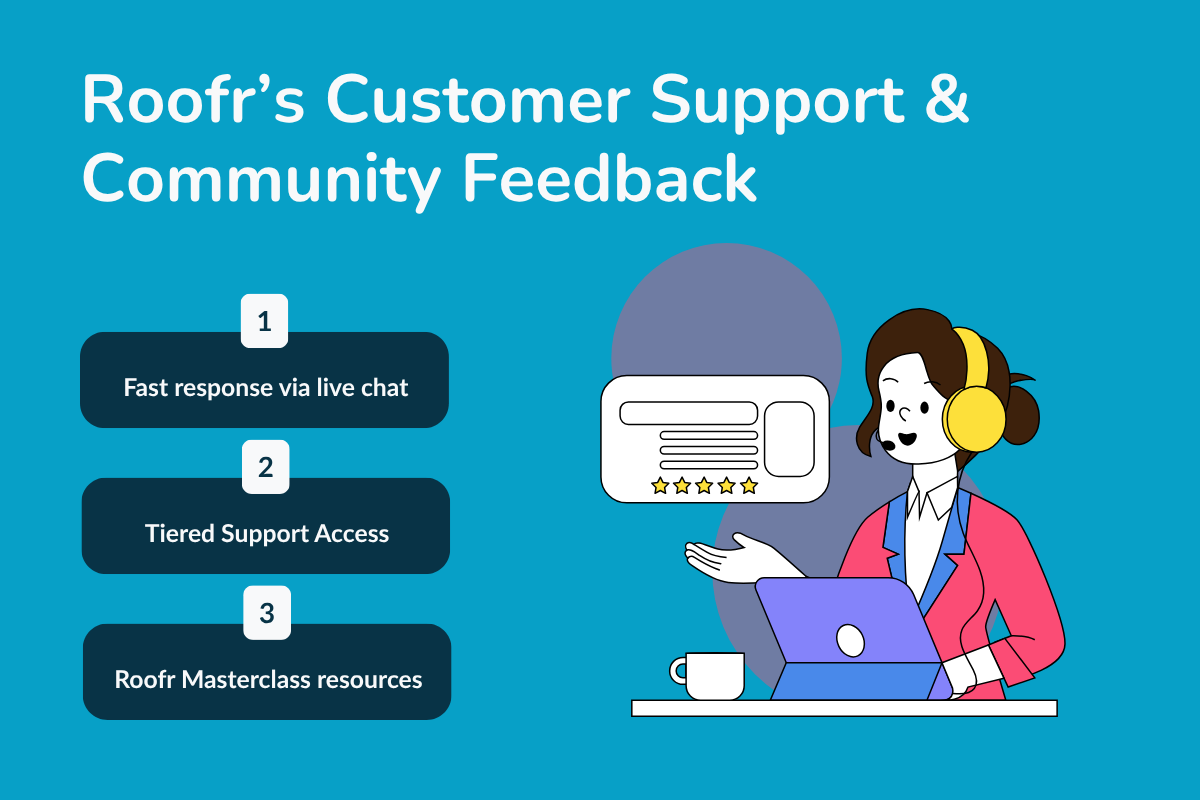
1. Responsiveness & Availability
Roofr’s support team earns solid marks for speed and accessibility. Most users report getting a response within a few hours through live chat, especially on paid plans.
Tickets tied to measurement errors or report delays are typically resolved the same day, which helps maintain project momentum.
2. Tiered Support Access
Support quality scales with your plan:
- Free & Pro users: standard chat + help center articles.
- Premium & Elite users: priority queues and dedicated account reps. During peak roofing seasons, response times can stretch slightly, but the team’s follow-through remains dependable.
3. Learning Resources
Roofr invests heavily in education through its Roofr Masterclass series, providing short, practical sessions that show how to get more from the platform.
Topics range from proposal workflows to ABC Supply integrations, helping contractors troubleshoot proactively rather than waiting for one-on-one support.
> Overall Impression
Contractors describe the experience as efficient and structured, aligning with Roofr’s overall product philosophy: make help easy to reach and solutions easy to apply.
It’s not white-glove support, but it’s consistent, and that reliability matters when you’re handling estimates and proposals on a tight schedule.
Roofr vs Other Roofing Software in 2025
The roofing software space has expanded fast. Tools like JobNimbus, AccuLynx, and Hover focus on full-cycle business management, while Roofr targets speed and simplicity in estimating and proposals.
This makes Roofr ideal for contractors who need quoting precision, not enterprise-level complexity.
1. Roofr
Roofr helps contractors measure roofs, create digital proposals, and close jobs faster. It’s designed for small to mid-sized residential teams that want speed and simplicity.
Features:
- Roof measurement reports (fast turnaround): Roofr provides accurate roof measurement reports within hours, eliminating the need for manual measuring or site visits
- Instant estimator for lead capture: This acts as a lead-generation tool, helping contractors capture more qualified prospects while giving homeowners immediate pricing transparency.
- Customizable proposals with e-signatures: With built-in e-signatures, customers can approve quotes instantly, speeding up the deal-closing process and reducing delays.
- Basic CRM: leads-to-payment workflow: Roofr includes a simple customer relationship management (CRM) system that tracks every stage, from lead generation to project completion and payment.
- Material ordering and integrated invoicing/payments: Roofr streamlines material ordering by integrating with suppliers and managing invoicing directly from the platform.
- Built-in calendar and job scheduling: The platform’s built-in calendar makes scheduling easy by letting contractors assign jobs, track progress, and manage multiple crews.
Pricing: Free plan available; paid plans start at $99/month for Pro and $169/month for Premium. Measurement reports are $19/report on the free plan and $13/report on subscriptions; Elite plans are available by contacting sales.
2. JobNimbus
JobNimbus is a CRM and project management platform designed for roofing businesses that require more advanced automation and team coordination. It centralizes leads, jobs, and payments into one system.
Features:
- Workflow automation and task management: JobNimbus automates repetitive tasks like follow-ups, reminders, and status updates, so teams can focus more on closing jobs rather than managing paperwork.
- Lead, job, and pipeline tracking: Contractors can easily view where each job stands, identify bottlenecks, and forecast revenue more accurately.
- Scheduling and calendar tools: With built-in scheduling and shared calendars, managers can assign jobs, plan crew availability, and avoid double bookings.
- Document, photo, and estimate management: All project-related files, such as contracts, photos, and estimates, are stored in a centralized location. This makes it easy to retrieve and share information instantly with teams or clients, reducing miscommunication.
- Invoicing and payment integrations: JobNimbus integrates with payment and accounting tools, allowing contractors to generate invoices, accept payments, and track financials without switching platforms.
- Role-based permissions and reporting: Built-in reporting tools provide insights into job progress, team performance, and sales trends.
Pricing: Quote-based; the public page does not publish prices, and third‑party examples vary depending on configuration and add‑ons.
3. AccuLynx
AccuLynx focuses on large-scale operations, connecting estimating, scheduling, production, and supplier ordering. It’s used by companies managing multiple crews and job sites.
Features:
- End-to-end job management for multi-crew operations: It centralizes everything from initial estimates to project completion, so managers can oversee all operations from one dashboard.
- Estimating and digital proposals: Create professional, branded estimates and proposals in minutes. Built-in templates and digital signatures make it easier to send, track, and close deals faster.
- Production scheduling and crew assignments: Easily schedule jobs, assign crews, and monitor progress in real time. Automated scheduling helps balance workloads and prevent downtime or overlap between projects.
- Supplier integrations and material ordering: AccuLynx integrates directly with major suppliers, allowing teams to order materials, check pricing, and manage deliveries without leaving the platform.
- Change orders, job costing, and reporting: Track every financial detail with built-in tools for job costing, change orders, and profit analysis. Real-time reporting helps contractors stay on budget and make data-driven decisions.
- Mobile access for field updates: Field crews can upload photos, update job statuses, and report progress directly from the AccuLynx mobile app, ensuring that office and field teams always stay in sync.
Pricing: Custom pricing only; contractors must request a quote.
4. Hover
Hover specializes in 3D roof and exterior modeling for precise measurements and photo‑realistic presentations. It pairs well with other CRMs or proposal tools for design‑driven contractors.
Features:
- 3D exterior models from photos: Hover generates detailed 3D models of building exteriors from just smartphone or drone photos.
- Accurate roof and facade measurements: It provides precise measurement reports, including roof pitch, surface area, and other façade dimensions.
- Takeoffs for estimating and material lists: Users can create material takeoffs and build estimates using the built-in tools based on the measurements.
- Visualizations and photo‑realistic renderings: Hover enables design visualizations (e.g., changing materials/colors) and presentational renders for clients.
- Integrations with estimating/CRM tools: The platform supports integrations and workflow hand-offs into estimating, CRM, and job-management systems.
- Project sharing for sales presentations: Users can share the generated models, measurement reports, and design visuals with clients or internal teams for sales and review.
Pricing: A pay-as-you-go model starting at $25 per job; higher-volume tiers are available upon request.
5. RooferBase
RooferBase is an all‑in‑one roofing platform that combines measurement, proposals, scheduling, project management, and payments in one workspace. It’s built for teams that want to replace multiple tools with a single platform.
Features:
- Roof measurements and estimating: With satellite or drone imaging integration, RooferBase enables accurate roof measurements without climbing ladders.
- Proposal generation with e‑signatures: You can generate branded, professional proposals in minutes—complete with material lists, labor costs, and visuals. Customers can sign digitally, allowing you to receive approvals faster and start jobs sooner.
- Scheduling, dispatch, and project tracking: RooferBase offers drag-and-drop scheduling tools to assign crews, plan deliveries, and manage job timelines.
- Invoicing and payments in one system: Generate invoices as soon as work finishes, send payment links, and track outstanding balances — all within the same system.
- Lead and web capture: RooferBase lets you automatically capture leads through web forms, door-to-door canvassing apps, and marketing campaigns, funneling all inquiries into one CRM.
Pricing: Custom pricing; tailored quotes available on request
Feature Comparison
| Platform | Core Focus | Ideal For | Stand-Out Strength | Limitation |
|---|---|---|---|---|
| Roofr | Roof measurements + proposals | Small to mid-size residential teams | Fast quoting, clean interface | Limited customization & mobile optimization |
| JobNimbus | CRM + project management | Growing teams with admin staff | Deep workflow automation | Steeper learning curve |
| AccuLynx | End-to-end roofing CRM | Larger operations | Advanced reporting & scheduling | Higher cost per seat |
| Hover | 3D imagery + design visualization | Exterior remodelers | Photogrammetry-based accuracy | Add-on pricing per project |
| RooferBase | Full-scale operations on one platform | Contractors wanting integration & transparency | All the tools in one login | Newer entrant, smaller ecosystem |
If you mainly care about quoting accuracy and proposal speed, Roofr still delivers the most efficient experience. But for teams ready to connect job tracking, payments, and customer management in one workspace, RooferBase closes that gap.
Also read: Choosing the Right Roofing Software in 2025: A Buyer’s Checklist
Where RooferBase Comes In: One Platform, Zero Hassle
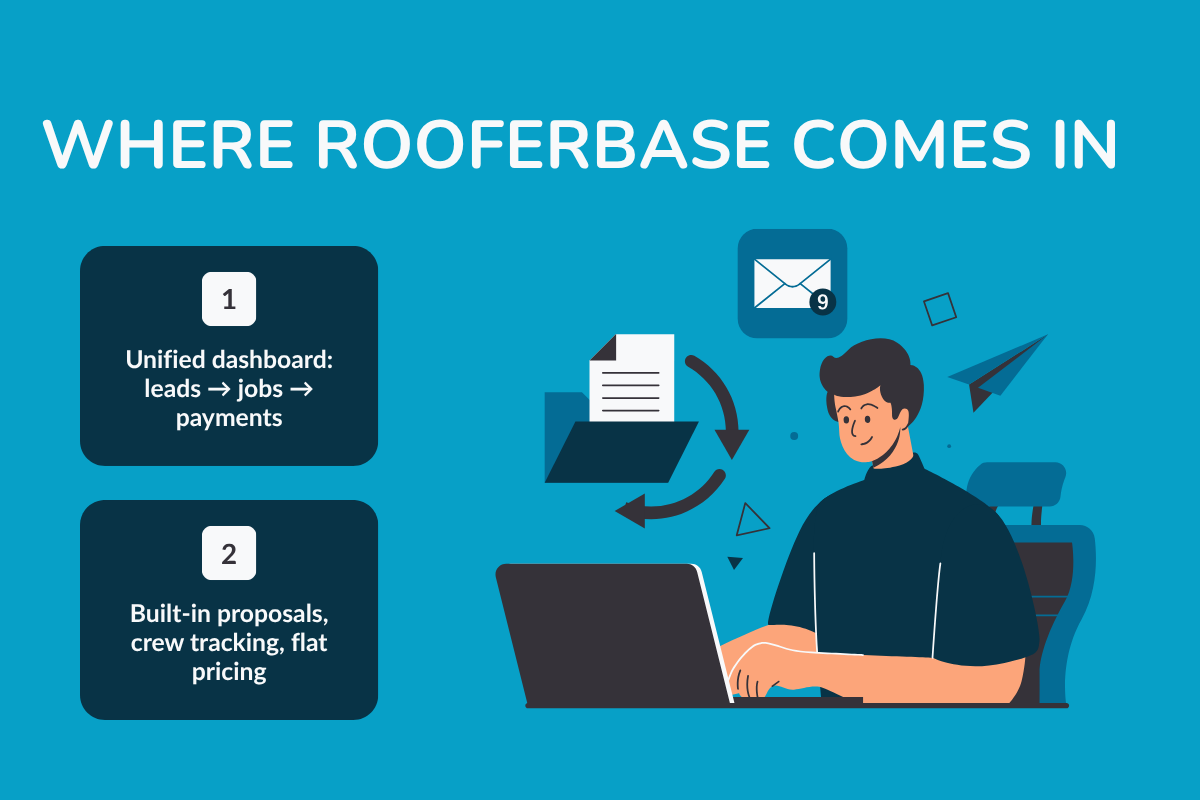
Many roofing companies started with Roofr for proposals or Hover for measurements, then added JobNimbus for CRM, plus separate apps for scheduling and payments.
The result is a cluttered tech stack that takes more time to manage than it saves.
RooferBase was designed to simplify that. It replaces the patchwork of tools with a single connected platform that handles quoting, project tracking, payments, and crew coordination in one workspace.
How RooferBase Works Differently
- Unified dashboard: Manage leads, jobs, invoices, and communication in a single view.
- Built-in measurement and proposal builder: Estimates flow directly into branded proposals without manual data entry.
- Job tracking and payments: Assign crews, track progress, and process payments from the same dashboard.
- Flat pricing: One plan that scales with your business, without separate “Pro” or “Elite” tiers.
Real-World Fit
Contractors who like Roofr’s speed but want all the tools under one roof tend to adopt RooferBase. It’s a natural fit for teams that want structure and automation without the overhead of enterprise software.
Why It Matters
Switching to RooferBase feels less like adding another tool and more like consolidating the business into a single system.
Contractors can sign deals, schedule jobs, and handle payments without jumping between tabs, making operations more efficient and predictable.
Also read: A Step-by-Step Guide to Rooferbase Roofing Project Management Software.
How RooferBase Differs from Roofr
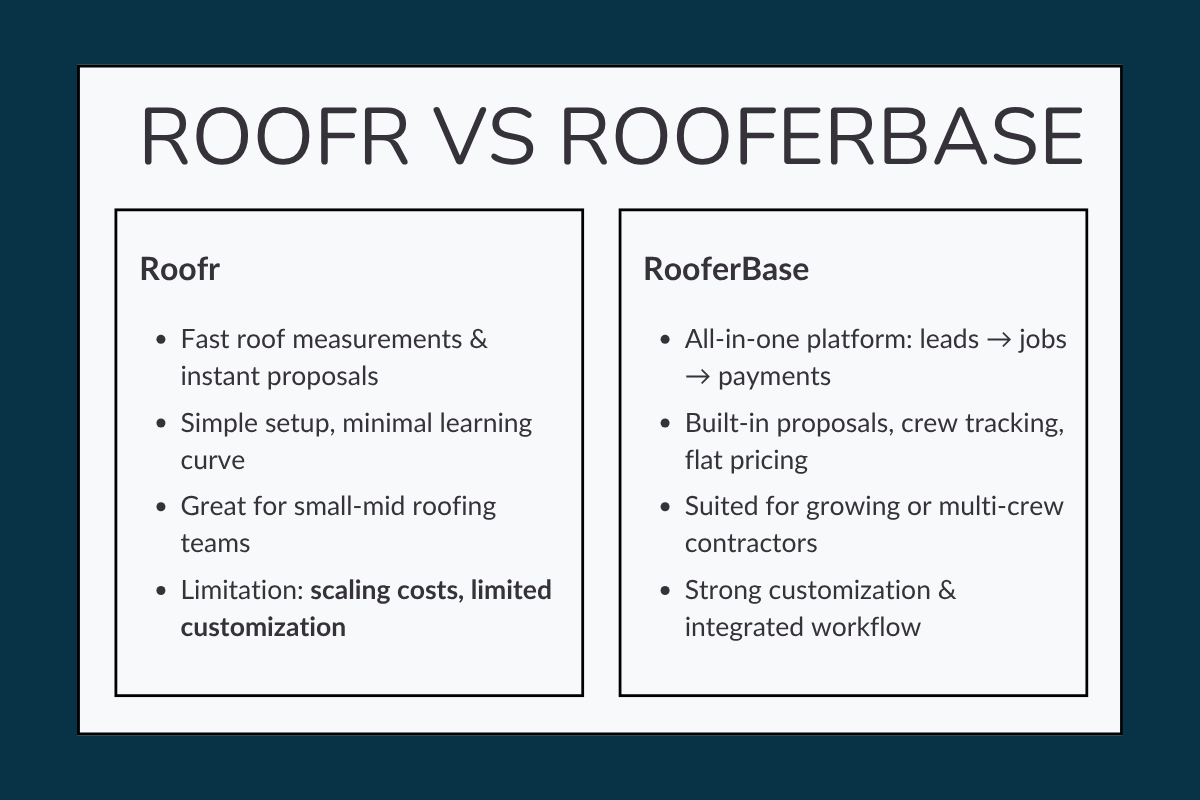
| Feature | Roofr | RooferBase |
|---|---|---|
| Focus | Measurement + Fully Branded Proposals | Full-scale roofing operations |
| Pricing | Tiered (Free, Pro, Premium, Elite) | Flat, budget-friendly |
| Customization | Limited | Highly customizable |
| Use Case | Residential roofing | Residential + commercial roofing |
| Ideal For | Small teams | Teams ready to scale |
Conclusion: Should You Choose Roofr or RooferBase?
Both Roofr and RooferBase reflect how quickly roofing technology is evolving. Roofr focuses on precision and simplicity for contractors who want to quote faster and look more professional. RooferBase focuses on consolidation, one platform for estimates, payments, and project management.
If you want to move fast and keep your workflow light, Roofr will do the job well. If you’re ready to centralize operations and scale efficiently, RooferBase will feel like the more natural next step. Either choice brings you closer to running your roofing business with fewer tools and better control.
Take the Next Step with RooferBase
If you’re ready to stop switching between apps and start managing your roofing business from one dashboard, it’s time to see what RooferBase can do.
Measure roofs, send proposals, track crews, and get paid, all in one platform built for contractors who want fewer tools and faster results. Schedule your demo today!
See how RooferBase simplifies every job: Explore RooferBase.
FAQs
1. What do Roofr users say about their experience?
Most contractors describe Roofr as straightforward and reliable, especially for quoting and proposal work. While there’s just the feedback about limited customization and mobile usability, users consistently highlight its speed and ease of use as major advantages.
2. How does the Roofr Proposal Tool work?
The Roofr proposal tool converts roof measurements and cost inputs into ready-to-send digital proposals. Contractors can add branding, pricing options, and e-signatures directly within the platform, helping them close deals faster and reduce time spent formatting estimates.
3. Does Roofr include free material calculations?
Yes. Roofr’s measurement reports automatically generate free material calculations that show estimated quantities of shingles, underlayment, and ridge caps. These reports help contractors plan jobs accurately without needing additional estimating software.


